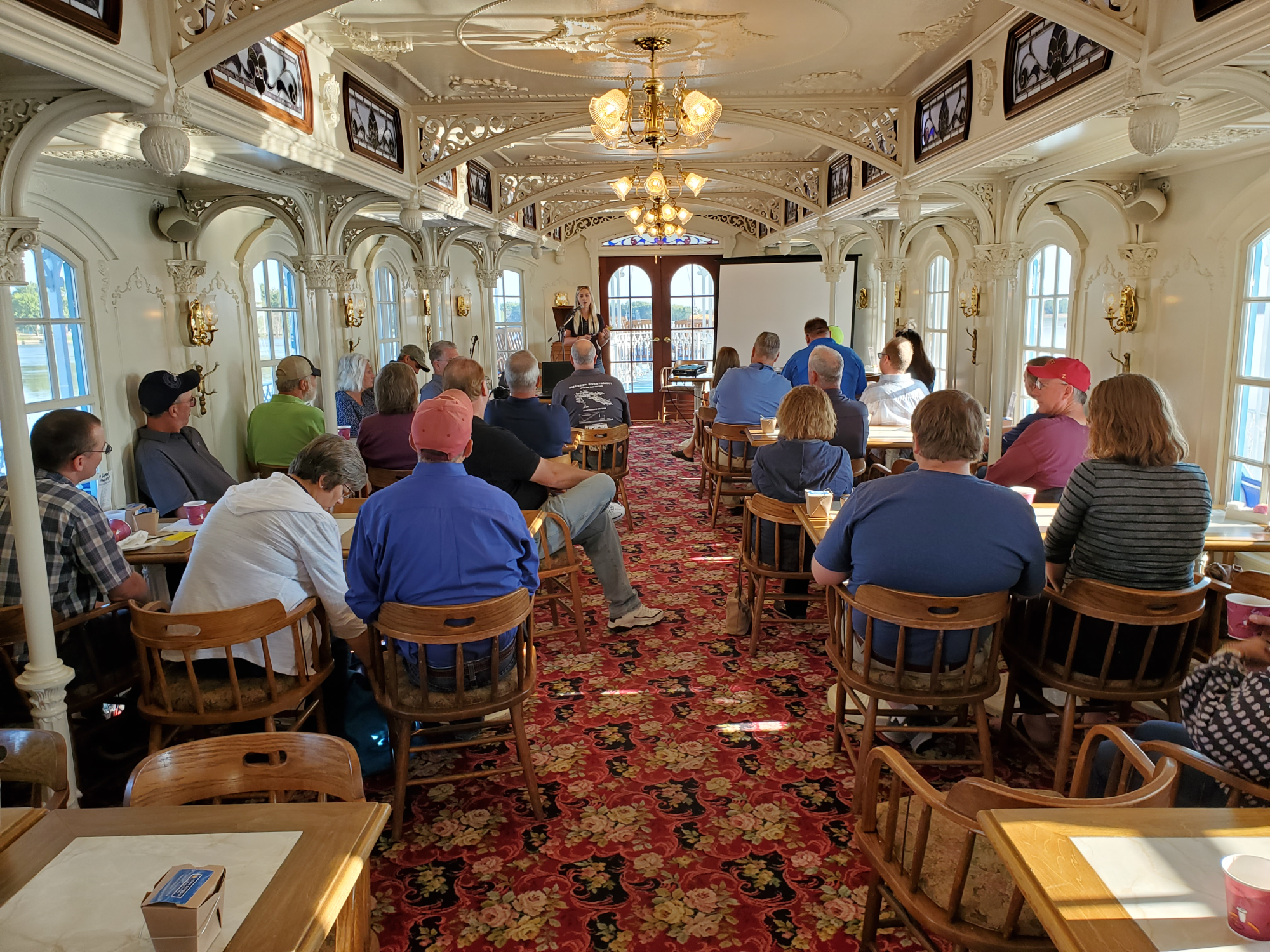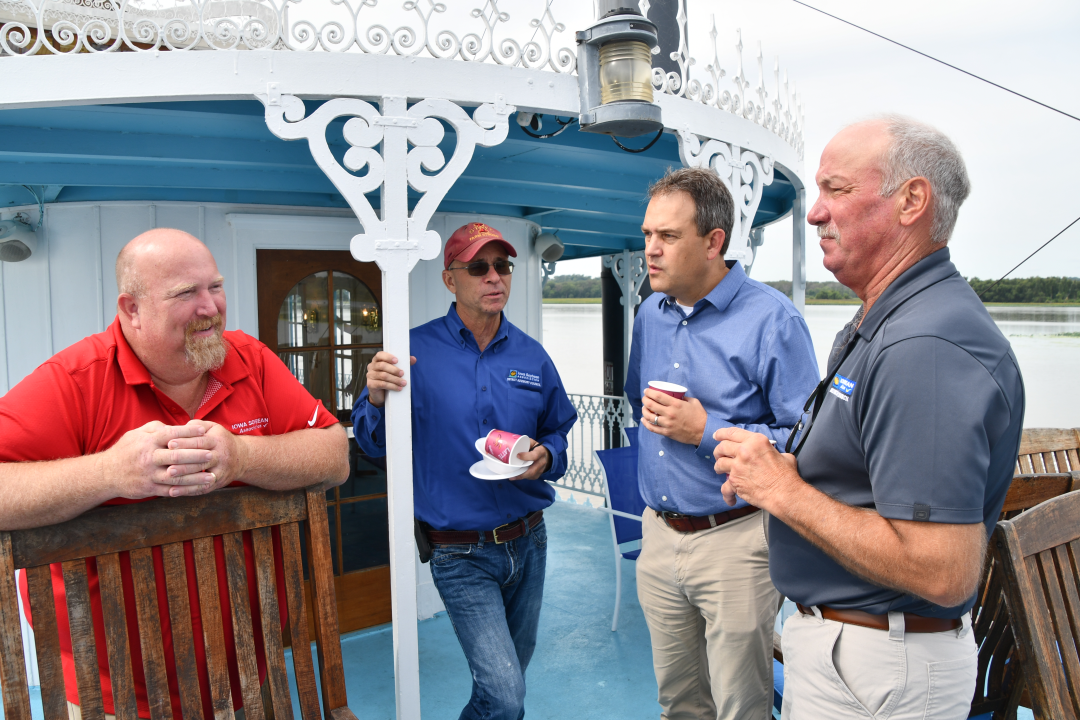Seeing is Believing as ISA Experience Class Tours Mississippi River by Boat
September 15, 2021 | Aaron Putze, APR
When it comes to understanding the economic and ecological importance of the Mississippi River, seeing is truly believing.
The Iowa Soybean Association (ISA) hosted farmer leaders and staff for an 83-mile journey of the river. The hands-on learning opportunity took place Sept. 1-2 aboard the Riverboat Twilight, sailing from LeClair to Dubuque.
“Seeing the river from the river is a unique setting and perspective for farmers,” said ISA president Robb Ewoldt. “It’s truly a once-in-a-lifetime opportunity to go through a lock chamber and see how grain moves from the vantage point of being on the water.”
The event, attended by 40 soybean leaders and ISA staff, culminated a year of discovery for farmers participating in the ISA Experience. Powered by Beck’s Hybrids, Bunge, REG and Latham Hi-Tech Seeds, Experience Class participants immerse themselves in four hands-on classes that provide them a thorough understanding of the association and issues impacting the soybean industry.
River navigation ranks high among topics affecting the profitability of soybean farmers. More than 60% of Iowa’s annual soybean harvest makes its way to the Gulf of Mexico courtesy of the Mighty Mississippi, including nearly every bushel grown by Ewoldt.
“You can’t overstate the river’s importance to the Iowa soybean farmers’ bottom line,” said the Davenport farmer from his perch aboard the bow of the riverboat. “Understanding the strategic value of the Mississippi and the investment required to keep it operational must be top-of-mind for growers as infrastructure has a lot to do with the price we receive for soybeans.”

Strategic importance
The Mississippi is America’s second-longest river (only the Missouri is longer). It’s also the chief river of the second-largest drainage system on the North American continent (exceeded only by the Hudson Bay).
From its headwaters in northern Minnesota, the river flows 2,320 miles, ending in the Mississippi River Delta in the Gulf of Mexico. All told, the river drains all or parts of 32 U.S. states and two Canadian Provinces.
Eleven locks and dams are located on the Mississippi River adjacent Iowa’s eastern border.
Tom Heinold oversees many of them and much of what happens on and along the river as chief of operations for the U.S. Army Corps of Engineers, Rock Island District. The Mississippi’s capabilities to transport aggregates, commodities, coal, fuel, wind turbines and other necessities risks being compromised by its rapidly aging infrastructure.
“The river’s locks and dams were built in the 1930s and 1940s,” he said. “Put another way, it was constructed 80-90 years ago with a 50-year life expectancy. Do the math. The system is getting old.”
As it ages, the river’s reliability as a conduit of Iowa-grown soybeans to international markets is compromised. Decaying locks create unsafe conditions for towing industry and lock personnel, jeopardizing consistency of service. It also makes barge navigation more inefficient.
Federal funding of the Mississippi River’s transportation system provides resources for routine operations and maintenance, major rehabilitation, and recapitalization. A minimum of $25 million is needed to refurbish a lock and dam for the next 25 years, Heinold said. Recapitalization projects, or construction of new infrastructure from the ground up, can cost more than $1 billion.
The system’s current replacement value is estimated at $268 billion. An appropriation of 4% annually – or $10.7 billion – is needed to provide baseline maintenance and construction.

Timeless approach
That infrastructure needs constant attention and updates as barge flotillas become larger and longer, said Soy Transportation Coalition Executive Director Mike Steenhoek. When constructed in the 1920s and ‘30s, lock lengths were 600 feet. Now, 1,200 feet is needed to accommodate additional vessels.
Of the 27 locks, only three have 1,200-foot chambers, Steenhoek said. To remain competitive, more chambers will need to be updated and lengthened and that will require additional and significant investments.
To place a finer point on the Mississippi’s importance, Steenhoek reminded the riverboat guests that people in China buy pork fed soybean meal made from soybeans grown in Iowa. They do so despite Iowa being located nearly 1,000 miles from the Gulf of Mexico and 6,500 miles separating Dubuque from Beijing.
That’s made possible due to the intermodal transportation system connecting supplies with demand, Steenhoek said.
“The moral of the story,” Steenhoek added, “is farmer profitability isn’t just a function of supply and demand but connecting supply and demand. The Mississippi River plays a key role in that connectivity.”
Look for an expanded version of this story in the November Iowa Soybean Review.
Back